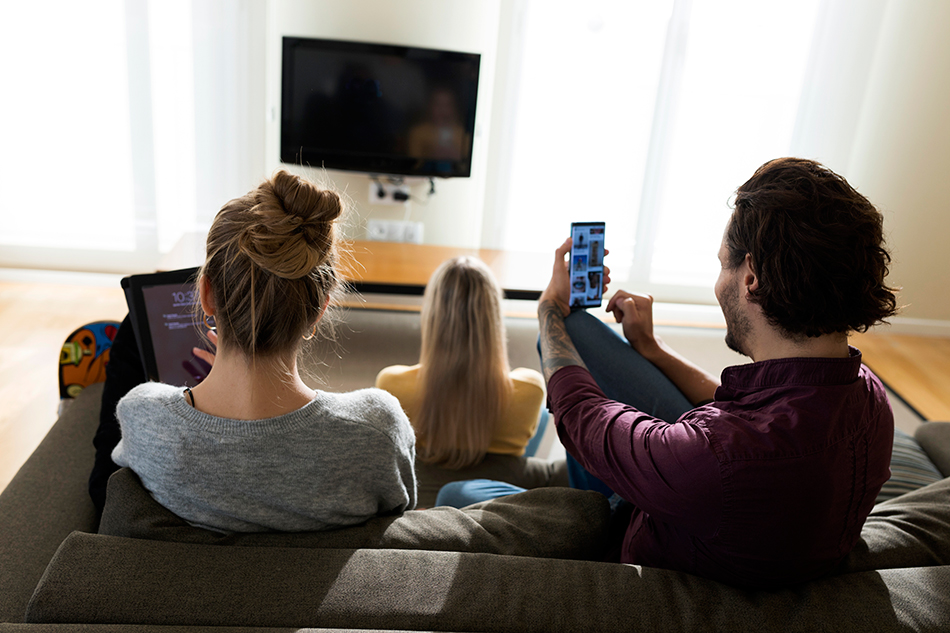Media Business Preps for New Normal
As the country began to settle in for what may be a prolonged period of working from home and limiting exposure to the outside world to curb the spread of the coronavirus, the media business is bracing for the long-term impact.
So far, the industry has managed to absorb a 10,000-point drop in the stock market, the indefinite delay of production schedules for programming, the cancellation of industry events and the postponement of pretty much every major sporting event for the foreseeable future. Along the way, Americans learned a new term — social distancing — and are readying themselves for what could be a months-long confinement to their homes.

Early on, the cable industry responded quickly to the outbreak, ensuring broad access to the internet by offering free broadband service to low-income homes, and vowing to keep WiFi hotspots open to all residents. About 390 telecom companies, including most large and small cable operators, also have committed to Federal Communications Commission chairman Ajit Pai’s Keep America Connected Pledge, vowing not to disconnect any broadband customer for nonpayment linked to the outbreak, and waive late fees.
Large operators like Comcast, Charter Communications, Cox Communications and Altice USA all extended their data networks to include more lower-income homes with school-age children, offering qualifying non-customers free access to broadband for 60 days.
Mediacom Communications chairman and CEO Rocco Commisso, whose company is raising broadband speeds and offering free service to qualifying homes for 60 days, said the outbreak has emphasized cable’s importance to a community as more and more people are needing reliable broadband to live their lives.
An Essential Service
“We are an essential service to people that have to work from home,” Commisso said. “The industry that is making that possible is the cable industry, and that makes me feel good.”
Multichannel Newsletter
The smarter way to stay on top of the multichannel video marketplace. Sign up below.
Mediacom executive VP of operations John Pascarelli said that the outbreak has given some people in its service territory who had been on the fence concerning buying broadband service a needed push.
“We’ve certainly seen an increase of households that may have been living on the edge with DSL or trying to make do with just the cellphone for data consumption in the home,” Pascarelli said. “They’ve hit a wall and are calling us to get service. Our sales levels are up significantly year-over-year in the last three days.”
With more people working from home, it could revitalize the home landline business, he added, as people look for more reliable connections than their cellphones.
Mediacom is about to launch a promotion to allow broadband customers to add landline phone service for $5 per month, Pascarelli said. But he added that the uncertainty of how long the outbreak will last and how intense it will be can worry consumers and providers as well.
“As a company we’ve dealt with storms, hurricanes, the California fires, and you know as you’re progressing through the end of it, you can see a recovery,” Pascarelli said. “In this situation it’s like we’re trying to manage a power outage and you can’t see the end of it. There’s no playbook for how we’re supposed to behave. We just continue to try to do what we think is right for our customers, our employees and our communities.”
Fitch Ratings director Patrice Cucinello said a lot of the impact will depend on how long home confinement lasts.
“Firms with better capitalized balance sheets, better liquidity situations, that are more diversified — they can manage through this period,” Cucinello said. “If this extends for a whole year, there are going to be a lot of businesses that face significant hurdles.”
Nowhere is that uncertainty more apparent than in the stock market, which has shed more than 10,000 points in the past several weeks. According to one former media executive who asked not to be named, don’t expect many major corporate decisions to be made while the market continues to be volatile.
Schedules to Fill
With all the major sports leagues — NBA, NHL, MLB, MLS and the PGA Tour — suspending their seasons indefinitely (see Programming, page 8), and with big events like the Kentucky Derby and the French Open tennis tournament pushed to September, there arises the question as to how networks that rely on that programming can fill the hole.
ESPN, for example, brought back “The Ocho” on March 22, airing 24-hours of arm wrestling matches, cherry-pit spitting, robot fighting and other seldom seen sports.
While that tongue-in-cheek effort could last for a while, there is a real concern that a prolonged lack of sports programming will be an incentive for fans to cut the pay TV cord.
“That scares me more than anything right now,” Pascarelli said. “If that group becomes disenchanted and says, ‘I can save money because there is nothing on that I want to watch,’ if they end up disconnecting, that is going to be an acceleration of video losses.”
Cucinello added that the impact of the sports blackout will all depend on the duration.
“If this is two or three months, then it is a postponement and it’s less material,” she said. “If it’s longer than that, I think that all bets are off.”
